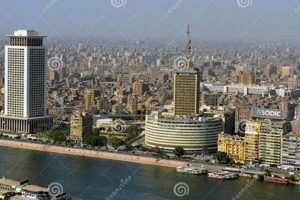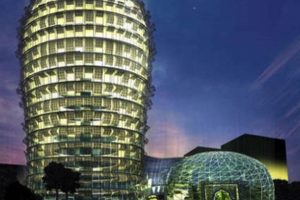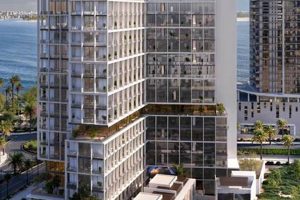Beijing, the capital of China, is renowned for its impressive skyline, dominated by a multitude of towering skyscrapers. These architectural marvels have transformed the city into a global financial and business hub, attracting numerous multinational corporations and prestigious institutions.
The construction of Beijing skyscrapers began in the late 20th century and has continued at an unprecedented pace, reshaping the city’s landscape. Notable examples include the iconic CCTV Headquarters, designed by Rem Koolhaas, and the China Zun Tower, the tallest building in Beijing. These skyscrapers not only provide substantial office and commercial space but also serve as symbols of China’s economic growth and technological advancements.
The presence of skyscrapers in Beijing has significantly impacted the city’s economy and infrastructure. They house major financial institutions, technology companies, and government agencies, contributing to Beijing’s position as a leading center for trade and investment. Furthermore, the construction and maintenance of these skyscrapers have created numerous employment opportunities in various sectors, including architecture, engineering, and real estate.
1. Height
The remarkable height of Beijing’s skyscrapers is an integral aspect of their identity and significance. The construction of towering buildings has been a defining characteristic of Beijing’s urban development, reshaping the city’s skyline and contributing to its global recognition.
The height of Beijing’s skyscrapers offers several advantages. Firstly, it provides ample space for offices, commercial ventures, and residential units, accommodating the city’s growing population and economic activities. Secondly, tall buildings serve as landmarks, creating a distinctive cityscape that attracts tourists and enhances the city’s overall appeal. Thirdly, the height of skyscrapers allows for innovative architectural designs and engineering feats, pushing the boundaries of construction technology.
The China Zun Tower, as the third tallest building globally, exemplifies the exceptional height achieved by Beijing’s skyscrapers. Standing at 528 meters, it dominates the city’s skyline and offers breathtaking panoramic views from its observation deck. The tower’s unique design, resembling a traditional Chinese zun wine vessel, has become an iconic symbol of Beijing’s architectural prowess.
In conclusion, the height of Beijing’s skyscrapers is not merely a physical attribute but a reflection of the city’s economic vitality, architectural ambition, and global prominence. These towering structures have transformed Beijing’s urban landscape, making it one of the most recognizable and dynamic cities in the world.
2. Architecture
Beijing’s skyscrapers are renowned for their innovative and striking architectural designs, which skillfully blend traditional Chinese elements with contemporary aesthetics. This unique approach to architecture has become an integral part of the city’s identity, showcasing its rich cultural heritage while embracing modern design principles.
The incorporation of traditional Chinese elements in Beijing’s skyscrapers is evident in various design aspects. Many buildings feature intricate patterns and motifs inspired by traditional Chinese art and architecture, such as the dragon-shaped roof of the China Central Television (CCTV) Headquarters. The use of traditional materials, such as glazed tiles and red lacquer, further enhances the sense of cultural continuity in these modern structures.
However, the architectural designs of Beijing’s skyscrapers are not merely limited to traditional elements. Contemporary aesthetics play a significant role in shaping the overall appearance and functionality of these buildings. The use of glass, steel, and other modern materials allows for sleek and soaring structures that reflect the city’s dynamic and forward-looking spirit. Many skyscrapers incorporate sustainable design features, showcasing China’s commitment to environmental consciousness.
The blend of traditional Chinese elements with contemporary aesthetics in Beijing’s skyscrapers has resulted in a unique architectural style that sets the city apart from other major metropolises. This approach not only preserves cultural heritage but also fosters innovation and creativity, contributing to Beijing’s reputation as a global architectural hub.
3. Sustainability
Beijing’s commitment to sustainability is evident in the eco-friendly features incorporated into many of its skyscrapers. This focus on sustainability reflects the city’s recognition of the importance of environmental consciousness and its alignment with global efforts to combat climate change.
The integration of eco-friendly features in Beijing skyscrapers takes various forms. Many buildings employ energy-efficient lighting systems, utilize renewable energy sources such as solar and wind power, and implement rainwater collection and recycling systems. Some skyscrapers also feature green roofs and vertical gardens, which help reduce air pollution and provide insulation, contributing to energy efficiency.
The adoption of sustainable practices in Beijing’s skyscrapers has several advantages. Firstly, it reduces the environmental impact of these massive structures, minimizing their carbon footprint and preserving the city’s air and water quality. Secondly, eco-friendly features can lead to significant cost savings in the long run, as buildings consume less energy and require less maintenance. Thirdly, sustainable skyscrapers contribute to the overall well-being of occupants by providing healthier and more comfortable indoor environments.
One notable example of a sustainable skyscraper in Beijing is the China Zun Tower, which has achieved LEED Platinum certification for its eco-friendly design. The building incorporates advanced energy-saving technologies, utilizes natural ventilation, and features a rainwater collection system that reduces water consumption. Another example is the Phoenix International Media Center, which boasts a double-skin facade that minimizes heat gain and utilizes natural daylighting to reduce energy consumption.
In conclusion, the incorporation of eco-friendly features in Beijing skyscrapers is a testament to the city’s commitment to sustainability and its recognition of the importance of environmental stewardship. These sustainable practices not only reduce the environmental impact of these buildings but also contribute to energy efficiency, cost savings, and the well-being of occupants. As Beijing continues to grow and develop, the integration of sustainability in its skyscrapers will undoubtedly play a vital role in shaping a more sustainable and livable urban environment.
4. Mixed
-use
The integration of mixed-use spaces in Beijing skyscrapers is a defining characteristic that contributes to the city’s vibrant and livable urban environment. By combining residential, commercial, and retail spaces within a single skyscraper, these buildings create self-contained microcosms that cater to the diverse needs of urban dwellers.
- Vertical Communities: Mixed-use skyscrapers foster a sense of community by bringing together people from different backgrounds and lifestyles within a single building. Residents can easily access essential amenities, such as shops, restaurants, and entertainment venues, without having to venture far from home.
- Convenience and Accessibility: The proximity of residential units to commercial and retail spaces provides unparalleled convenience for residents. They can easily run errands, shop for groceries, or enjoy a night out without the need for extensive travel or traffic congestion.
- Economic Vitality: Mixed-use skyscrapers contribute to the economic vitality of Beijing by creating a thriving hub of activity. The presence of retail and commercial spaces within these buildings attracts businesses and generates employment opportunities, benefiting the local economy.
- Reduced Environmental Impact: By encouraging people to live, work, and shop within a single building, mixed-use skyscrapers promote sustainable living and reduce the environmental impact associated with commuting and urban sprawl.
In conclusion, the integration of mixed-use spaces in Beijing skyscrapers is a key factor in creating vibrant, self-contained, and sustainable urban environments. These buildings foster a sense of community, provide unparalleled convenience, contribute to economic growth, and promote environmental consciousness, making them an integral part of Beijing’s thriving cityscape.
5. Economic Hub
Beijing’s skyscrapers play a pivotal role in the city’s economic growth by providing a central hub for major financial institutions and multinational corporations. These towering structures house the headquarters and regional offices of leading banks, investment firms, and technology companies, both domestic and international.
- Financial Hub: Beijing’s skyscrapers are home to the headquarters of major Chinese banks, such as the Industrial and Commercial Bank of China (ICBC) and the Bank of China, as well as international financial institutions like HSBC and Citibank. These financial institutions play a crucial role in financing businesses, facilitating trade, and managing investments, contributing to the city’s economic vitality.
- Multinational Headquarters: Many multinational corporations have chosen Beijing as their regional headquarters for operations in China and the Asia-Pacific region. The presence of these companies, such as Microsoft, Apple, and Volkswagen, brings foreign investment, creates employment opportunities, and fosters knowledge transfer, contributing to Beijing’s economic growth and global competitiveness.
- Innovation and Entrepreneurship: Beijing’s skyscrapers also house numerous startups, venture capital firms, and incubators, creating an ecosystem that supports innovation and entrepreneurship. The proximity to financial institutions and multinational corporations provides startups with access to funding, mentorship, and potential partnerships, fostering the growth of new businesses and contributing to the city’s economic diversification.
- Skilled Workforce: Beijing’s skyscrapers attract a highly skilled workforce from across China and abroad. These professionals possess expertise in finance, technology, and various industries, contributing to the city’s intellectual capital and driving economic growth.
In conclusion, Beijing’s skyscrapers serve as an economic hub that brings together major financial institutions, multinational corporations, startups, and skilled professionals. This concentration of economic activity contributes significantly to Beijing’s economic growth, making it one of the leading financial and business centers in the world.
6. Landmark
The emergence of iconic skyscrapers as landmarks in Beijing is closely intertwined with the city’s rapid urbanization and architectural transformation. These skyscrapers have become symbols of Beijing’s economic prosperity, technological advancements, and global prominence.
The architectural significance of Beijing’s iconic skyscrapers lies in their innovative designs and engineering feats. Buildings like the CCTV Headquarters, designed by Rem Koolhaas, have pushed the boundaries of architectural expression, showcasing unique forms and structures. These skyscrapers have become instantly recognizable symbols of the city, attracting tourists and architectural enthusiasts from around the world.
The status of these skyscrapers as landmarks has practical implications. They serve as orientation points within the city’s vast urban landscape, helping people navigate and explore Beijing. Additionally, these landmarks contribute to the city’s cultural and tourism sectors, generating revenue and promoting Beijing as a global destination.
Furthermore, the presence of iconic skyscrapers in Beijing has influenced urban planning and architectural trends. These buildings have set new standards for sustainable design and technological integration, inspiring future developments in the city and beyond. They represent Beijing’s commitment to innovation and its aspiration to be a leading global metropolis.
In conclusion, the landmark status of iconic skyscrapers in Beijing is a testament to their architectural significance and the city’s rapid transformation. These skyscrapers have become symbols of Beijing’s economic growth, technological advancements, and global recognition, while also contributing to the city’s cultural landscape, tourism industry, and urban development.
7. Tourism
The connection between tourism and Beijing’s skyscrapers is mutually beneficial and contributes to the city’s overall appeal. Skyscrapers, with their towering heights and unique architectural designs, have become iconic landmarks that draw tourists from around the world.
Many Beijing skyscrapers offer observation decks and other attractions that provide breathtaking panoramic views of the city. These attractions, such as the observation deck at the China Zun Tower or the revolving restaurant at the CCTV Headquarters, allow visitors to experience the city from a unique perspective.
The presence of skyscrapers as tourist attractions has several practical implications. Firstly, it generates revenue for the city through ticket sales and other tourism-related activities. Secondly, it enhances Beijing’s reputation as a global destination, attracting visitors who are interested in architecture, urban planning, and modern landmarks.
Furthermore, the development of skyscrapers with observation decks
and other tourist attractions fosters a positive feedback loop. As more skyscrapers are built and offer unique experiences, Beijing becomes an increasingly attractive destination for tourists. This, in turn, encourages further investment in skyscraper construction and the development of new and innovative attractions.
In conclusion, the connection between tourism and Beijing’s skyscrapers is a key factor in the city’s economic growth and global recognition. By offering unique and unforgettable experiences, Beijing’s skyscrapers have become must-see attractions for tourists, contributing to the city’s tourism industry and overall prosperity.
8. Urban Planning
The construction of skyscrapers in Beijing has had a profound impact on the city’s urban planning, influencing its overall development and infrastructure. As skyscrapers emerged, urban planners had to adapt and innovate to accommodate these towering structures while ensuring the city remained livable and sustainable.
One significant aspect of this influence is the need for efficient transportation systems. Skyscrapers concentrate a large number of people and businesses in a relatively small area, creating a high demand for transportation infrastructure. Urban planners have responded by developing comprehensive transportation networks that include subways, buses, and dedicated lanes for pedestrians and cyclists. These networks help manage the flow of people and vehicles, reducing congestion and improving accessibility to and from skyscrapers.
Another important consideration is the provision of adequate public spaces and green areas. Skyscrapers can create dense urban environments, so urban planners have prioritized the creation of parks, plazas, and other public spaces to provide respite and recreational opportunities for residents and visitors. These spaces also contribute to the overall livability and well-being of the city.
Furthermore, the construction of skyscrapers has influenced the distribution of businesses and services within Beijing. Skyscrapers often house corporate headquarters, financial institutions, and other businesses, leading to the creation of central business districts. This concentration of economic activity has shaped the city’s economic geography and created new opportunities for businesses and residents.
In summary, the construction of skyscrapers in Beijing has had a significant influence on urban planning, leading to the development of efficient transportation systems, the provision of public spaces and green areas, and the shaping of the city’s economic geography. Understanding this connection is crucial for managing the challenges and opportunities presented by skyscrapers in urban environments.
Frequently Asked Questions about Beijing Skyscrapers
This section addresses common questions and misconceptions regarding Beijing’s skyscrapers, providing informative answers to enhance understanding.
Question 1: What is the tallest skyscraper in Beijing?
Answer: The tallest skyscraper in Beijing is the China Zun Tower, standing at 528 meters tall with 109 floors.
Question 2: How many skyscrapers are there in Beijing?
Answer: As of 2023, Beijing has over 500 skyscrapers, with more under construction.
Question 3: Are Beijing’s skyscrapers earthquake-proof?
Answer: Yes, Beijing’s skyscrapers are designed to withstand earthquakes. The city is located in a seismic zone and has strict building codes to ensure structural safety.
Question 4: Do Beijing’s skyscrapers have green features?
Answer: Many Beijing skyscrapers incorporate sustainable design elements, such as energy-efficient lighting, rainwater collection systems, and green roofs.
Question 5: Can tourists visit the observation decks of Beijing’s skyscrapers?
Answer: Yes, some Beijing skyscrapers, such as the China Zun Tower and the CCTV Headquarters, offer observation decks open to the public.
Question 6: What is the impact of Beijing’s skyscrapers on the city’s environment?
Answer: While skyscrapers can contribute to urban density and energy consumption, the implementation of green building practices and efficient transportation systems mitigates their environmental impact.
In summary, Beijing’s skyscrapers are notable for their height, number, safety features, sustainability efforts, tourist attractions, and overall impact on the city’s environment and urban development.
Transition to the next article section:
With their iconic designs and contributions to the city’s skyline, economy, and global recognition, Beijing’s skyscrapers continue to shape the urban landscape and attract worldwide attention.
Tips for Experiencing Beijing’s Skyscrapers
Beijing’s skyscrapers offer a unique blend of architectural marvels and cultural significance. To fully appreciate these iconic structures, consider the following tips:
Tip 1: Visit Observation Decks: Ascend to the observation decks of skyscrapers like the China Zun Tower or CCTV Headquarters for breathtaking panoramic views of the city. Explore different vantage points to capture the vastness and detail of Beijing’s urban landscape.
Tip 2: Explore Mixed-Use Spaces: Utilize the convenience of mixed-use skyscrapers that combine residential, commercial, and retail spaces. Enjoy shopping, dining, and entertainment options right at your doorstep, immersing yourself in the vibrant urban atmosphere.
Tip 3: Discover Architectural Details: Take time to admire the intricate designs and innovative architectural elements of Beijing’s skyscrapers. Pay attention to unique facades, structural features, and sustainable elements that contribute to the city’s architectural identity.
Tip 4: Learn about Sustainability Efforts: Inquire about the eco-friendly features incorporated into Beijing’s skyscrapers. Discover how these buildings contribute to energy efficiency, water conservation, and environmental protection, showcasing China’s commitment to sustainable urban development.
Tip 5: Consider Historical Context: Understand the historical significance of Beijing’s skyscrapers and their role in the city’s economic growth and transformation. Trace the evolution of architectural styles and engineering advancements that have shaped Beijing’s skyline.
By following these tips, you can maximize your experience of Beijing’s skyscrapers, appreciating their architectural grandeur, functionality, and contribution to the city’s dynamic urban fabric.
Conclusion
Beijing’s skyscrapers stand as testaments to the city’s economic prosperity, architectural ingenuity, and global significance. Their towering heights, innovative designs, and sustainable features have transformed Beijing’s skyline, making it one of the most recognizable and dynamic urban landscapes in the world.The integration of mixed-use spaces, observation decks, and eco-friendly elements in these skyscrapers caters to the diverse needs of urban dwellers while promoting convenience, sustainability, and cultural appreciation. As Beijing continues to grow and evolve, its skyscrapers will undoubtedly play an increasingly vital role in shaping its future urban development and global stature.The exploration of Beijing’s skyscrapers highlights the importance of sustainable urban planning, architectural innovation, and the harmonious integration of modern structures within the cultural fabric of a city. These s
kyscrapers serve not only as landmarks but also as catalysts for economic growth, tourism, and the overall well-being of Beijing’s residents.







